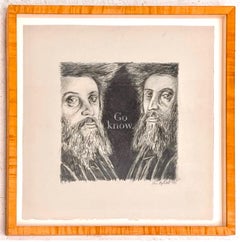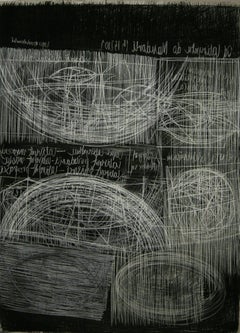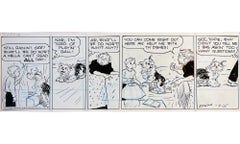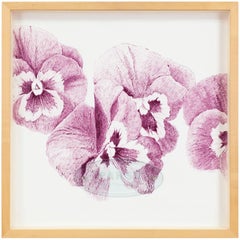Ken Aptekar Art
to
2
Overall Width
to
Overall Height
to
2
2
1
1
1
1
1
2
8,779
2,809
1,642
1,313
2
Artist: Ken Aptekar
Ken Aptekar Contemporary Conceptual Judaica Art Drawing Go Study Chasidic Rabbis
By Ken Aptekar
Located in Surfside, FL
Ken Aptekar
American (b. 1950)
Go Know (Study)
1996
Graphite, white pigment, transparency film, and staples on paper
Hand signed lower right
sheet: 18 x 18 inches
frame dimensions: 21 x 21 x 1 3/4 inches, wood frame with acrylic glazing
Ken Aptekar is an artist who combines painting with text. He paints new versions of historical paintings and frames, bolting glass with sandblasted words to his painted panels. Aptekar’s work belongs to the tradition of painting, yet he brings to that tradition a recognition that paintings produce meaning only through their interaction with viewers. He investigates the nature of spectatorship. By “recreating” works of art in a painterly but utilitarian manner, Aptekar promotes viewers’ own narratives prompted by the image-text combinations.
Born in Detroit, Aptekar received his BFA at the University of Michigan, then moved to Brooklyn to complete an MFA at Pratt Institute. Most recently, his work was featured at the Jewish Museum in Vienna, Austria, and in the Biennale Internationale d’Autun, in Autun, France. A major commissioned solo exhibition, NACHBARN (“NEIGHBORS”), 2016, was on view at the St. Annen Museum in Lübeck, Germany, including paintings with text, silverpoint drawings, and video all based upon medieval altarpieces in the St. Annen Museum’s collection.
Previously, his work has been seen in solo exhibitions at the Victoria & Albert Museum in collaboration with the Serpentine Gallery (London), the Corcoran Gallery of Art (Washington, DC), Memorial Art Gallery (Rochester, NY), Centro da Cultura Judaica (Sao Paolo, Brazil), Musée Robert Dubois-Corneau (Brunoy, France), the New Museum (New York, NY), Douglas Cooley Gallery at Reed College (Portland, OR), Palmer Museum of Art at Penn State (State College, PA), Cummer Museum (Jacksonville, FL), and the Elaine Jacob Gallery at Wayne State University (Detroit, MI). In 2012 Aptekar’s work was the subject of a survey exhibition, “Ken Aptekar: Look Again,” at the Beard and Weil Galleries, Wheaton College, Massachusetts. He was in the show Words & Music
with John Giorno, Cheonae Kim...
Category
Late 20th Century Conceptual Ken Aptekar Art
Materials
Paper, Film, Graphite, Pigment
THE NAME OF THE FLOWER: PANSY “JOKER VIOLA-GOLD”
By Ken Aptekar
Located in Surfside, FL
Genre: Contemporary
Subject: Nature
Medium: Ink, Sandblasted Glass,
Surface: Paper
Country: United States
Dimensions: 20" x 20"
Dimensions w/Frame: 21" x 21" x 2"
KEN APTEKAR (b.19...
Category
Late 20th Century Conceptual Ken Aptekar Art
Materials
Glass, Ink
Related Items
Drawing 14, Series Drawing - Large Format, Charcoal On Paper Panting
By Krzysztof Gliszczyński
Located in Salzburg, AT
The artwork is unframed and will be shipped rolled in a tube
Krzysztof Gliszczyński is Professor for painting on Academy of fine arts Gdansk.
Krzysztof Gliszczyński born in Miastko in 1962. Graduated from the Gdańsk Academy of Fine Arts in 1987 in the studio of Prof. Kazimierz Ostrowski. Between 1995 and 2002 founder and co-manager of Koło Gallery in Gdańsk. lnitiator of the Kazimierz Ostrowski Award, con-ferred by the Union of Polish Artists and Designers (ZPAP), Gdańsk Chapter. Dean of the Painting Faculty of the Gdańsk Academy of Fine Arts in the years 2008-2012. Vice Rector for Development and Cooperation of the Gdańsk Academy of Fine Arts in the years 2012-2016. Obtained a professorship in 2011. Currently head of the Third Painting Studio of the Painting Faculty of the Gdańsk Academy of Fine Arts. He has taken part in a few dozen exhibitions in Poland and abroad. He has received countless prizes and awards for his artistic work. He is active in the field of painting, drawing, objects, and video.
Artist Statement
In the 1990s I started collecting flakes of paint – leftovers from my work. I would put fresh ones in wooden formworks, dried ones in glass containers. They constituted layers of investigations into the field of painting, enclosed in dated and numbered cuboids measuring 47 × 10.5 × 10.5 cm. I called those objects Urns. In 2016, I displayed them at an exhibition, moulding a single object out of all the Urns. The Urns inspired me to redefine the status of my work as a painter. In order to do it, I performed a daunting task of placing the layers of paint not in an urn, but on a canvas, pressing each fresh bit of paint with my thumb. In the cycle of paintings Autoportret a’retour, the matter was transferred from painting to painting, expanding the area of each consecutive one. Together, the bits, the residua of paint, kept alive the memory of the previous works. It was a stage of the atomization of the painting matter and its alienation from the traditional concepts and aesthetic relations. Thus, the cycle of synergic paintings was created, as I called them, guided by the feeling evoked in me by the mutually intensifying flakes of paint. The final aesthetic result of the refining of the digested matter was a consequence of the automatism of the process of layering, thumb-pressing, and scraping off again. Just like in an archaeological excavation, attempts are made to unite and retrieve that which has been lost. This avant-garde concept consists in transferring into the area of painting of matter, virtually degraded and not belonging to the realm of art. And yet the matter re-enters it, acquiring a new meaning. The matter I created, building up like lava, became my new technique. I called it perpetuum pictura – self-perpetuated painting. Alchemical concepts allowed me to identify the process inherent in the emerging matter, to give it direction and meaning. In a way, I created matter which was introducing me into the pre-symbolic world – a world before form, unnamed. From this painterly magma, ideas sprung up, old theories of colour and the convoluted problem of squaring the circle manifested themselves again. Just like Harriot’s crystal refracted light in 1605, I tried to break up colour in the painting Iosis. Paintings were becoming symptoms, like in the work Pulp fiction, which at that time was a gesture of total fragmentation of matter and of transcending its boundaries, my dialogue with the works of Jackson Pollock and the freedom brought by his art. The painting Geometrica de physiologiam pictura contains a diagram in which I enter four colours that constitute an introduction to protopsychology, alchemical transmutation, and the ancient theory of colour. It this work I managed to present the identification of the essence of human physiology with art. But the essential aspect of my considerations in my most recent paintings is the analysis of abstraction, the study of its significance for the contemporary language of art and the search for the possibilities of creating a new message. For me, abstraction is not an end in itself, catering to the largely predicable expectations of the viewers. To study the boundary between visibility and invisibility, like in the work Unsichtbar, is to ask about the status of the possibilities of the language of abstraction. The moment of fluidity which I am able to attain results from the matter – matter...
Category
Early 2000s Conceptual Ken Aptekar Art
Materials
Paper, Charcoal
$2,978
H 78.75 in W 59.06 in
Tippie Comic Strip Original Art - Female Cartoonist
Located in Miami, FL
An early example from pioneering Female Cartoonist/ Illustrator Edwina Dumm, who draws a comic strip from her long-running cartoon series Tippie which lasted for almost five decades. Signed and dated Edwina, 9-25, matted but unframed.
Frances Edwina Dumm (1893 – April 28, 1990) was a writer-artist who drew the comic strip Cap Stubbs and Tippie for nearly five decades; she is also notable as America's first full-time female editorial cartoonist. She used her middle name for the signature on her comic strip, signed simply Edwina.
Biography
One of the earliest female syndicated cartoonists, Dumm was born in Upper Sandusky, Ohio, and lived in Marion and Washington Courthouse, Ohio throughout her youth before the family settled down in Columbus.[1] Her mother was Anna Gilmore Dennis, and her father, Frank Edwin Dumm, was an actor-playwright turned newspaperman. Dumm's paternal grandfather, Robert D. Dumm, owned a newspaper in Upper Sandusky which Frank Dumm later inherited. Her brother, Robert Dennis Dumm, was a reporter for the Columbus Dispatch, and art editor for Cole Publishing Company's Farm & Fireside magazine.
In 1911, she graduated from Central High School in Columbus, Ohio, and then took the Cleveland-based Landon School of Illustration and Cartooning correspondence course. Her name was later featured in Landon's advertisements. While enrolled in the correspondence course, she also took a business course and worked as a stenographer at the Columbus Board of Education.
In 1915, Dumm was hired by the short-lived Republican newspaper, the Columbus Monitor, to be a full-time cartoonist.[2] Her first cartoon was published on August 7, 1915, in the debut issue of the paper. During her years at the Monitor she provided a variety of features including a comic strip called The Meanderings of Minnie about a young tomboy girl and her dog, Lillie Jane, and a full-page editorial cartoon feature, Spot-Light Sketches[3]. She drew editorial cartoons for the Monitor from its first edition (August 7, 1915) until the paper folded (July 1917). In the Monitor, her Spot-Light Sketches was a full-page feature of editorial cartoons, and some of these promoted women's issues. Elisabeth Israels Perry, in the introduction to Alice Sheppard's Cartooning for Suffrage (1994), wrote that artists such as Blanche Ames Ames, Lou Rogers and Edwina Dumm produced:
...a visual rhetoric that helped create a climate more favorable to change in America's gender relations... By the close of the suffrage campaign, women's art reflected the new values of feminism, broadened its targets, and attempted to restate the significance of the movement.[4]
After the Monitor folded, Dumm moved to New York City, where she continued her art studies at the Art Students League. She was hired by the George Matthew Adams Service[5] to create Cap Stubbs and Tippie, a family strip following the lives of a boy Cap, his dog Tippie, their family, and neighbors. Cap's grandmother, Sara Bailey, is prominently featured, and may have been based on Dumm's own grandmother, Sarah Jane Henderson, who lived with their family. The strip was strongly influenced by Mark Twain’s Adventures of Huckleberry Finn, as well as Dumm’s favorite comic, Buster Brown by Richard F. Outcault. Dumm worked very fast; according to comics historian Martin Sheridan, she could pencil a daily strip in an hour.[6]
Her love of dogs is evident in her strips as well as her illustrations for books and magazines, such as Sinbad, her weekly dog page which ran in both Life and the London Tatler. She illustrated Alexander Woollcott's Two Gentlemen and a Lady. For Sonnets from the Pekinese and Other Doggerel (Macmillan, 1936) by Burges Johnson (1877–1963), she illustrated "Losted" and other poems.
From the 1931 through the 1960s, she drew another dog for the newspaper feature Alec the Great, in which she illustrated verses written by her brother, Robert Dennis Dumm. Their collaboration was published as a book in 1946. In the late 1940s, she drew the covers for sheet music by her friend and neighbor, Helen Thomas, who did both music and lyrics. During the 1940s, she also contributed Tippie features to various comic books including All-American Comics and Dell Comics.
In 1950, Dumm, Hilda Terry, and Barbara Shermund...
Category
1920s Conceptual Ken Aptekar Art
Materials
Ink, Color Pencil, Graphite
Cecilia Arrospide - DESCANSANDO II, Drawing 2019
By Cecilia Arrospide
Located in Greenwich, CT
Engraving Intervened
My work is mainly abstract, I would say abstract expressionism. I love painting with oils, they give me many possibilities I do no find in other media. When w...
Category
2010s Conceptual Ken Aptekar Art
Materials
Paper, Engraving
Drawing 13, Series Drawing - Large Format, Charcoal On Paper Panting
By Krzysztof Gliszczyński
Located in Salzburg, AT
The artwork is unframed and will be shipped rolled in a tube
Krzysztof Gliszczyński is Professor for painting on Academy of fine arts Gdansk. ...
Category
Early 2000s Conceptual Ken Aptekar Art
Materials
Paper, Charcoal
$2,980
H 78.75 in W 59.06 in
USE WHAT IS DOMINANT IN A CULTURE TO CHANGE IT: Signed glass bowl Whitney Museum
By Jenny Holzer
Located in New York, NY
Jenny Holzer
USE WHAT IS DOMINANT IN A CULTURE TO CHANGE IT, 2003
Hand Blown Glass Bowl
4 × 10 × 10 inches
Edition 68/200
Signed and numbered 68/200 on the underside with Holzer's in...
Category
Early 2000s Conceptual Ken Aptekar Art
Materials
Blown Glass, Engraving
Caricature. "A bon chat bon rat" lithograph on paper, 30x22 cm
By Honoré Daumier
Located in Riga, LV
Honore-Victor Daumier (1808–1879) - Caricature. "A bon chat bon rat" lithograph on paper, 30x22 cm
Category
1840s Conceptual Ken Aptekar Art
Materials
Paper, Lithograph
$467 Sale Price
20% Off
H 11.82 in W 8.67 in D 0.04 in
Abeni (We Prayed for Her and She Arrived) -21st Century, Contemporary Figurative
Located in Ibadan, Oyo
Shipping Procedure
FREE Shipping Worldwide
Ships in a well-protected tube.
This work is unique, not a print or other type of copy.
Accompanied by a Certificate of Authenticity.
The ...
Category
21st Century and Contemporary Conceptual Ken Aptekar Art
Materials
Paper, Ink, Acrylic
$1,750
H 15.4 in W 11 in D 1 in
Identical Twin - 21st Century, Contemporary, Figurative Indigenous Art, Cultural
Located in Ibadan, Oyo
Shipping Procedure
FREE Shipping Worldwide
Ships in a well-protected tube.
This work is unique, not a print or other type of copy.
Accompanied by a Certificate of Authenticity.
Having been nurtured by a Yoruba father who happens to be a twin was a major inspiration for creating this painting. In Yoruba culture, twins are considered a special blessing from God. They are mostly called ‘ibeji’ which means twins. In Yoruba society, twins are given special names, such as Taiwo (meaning “first to taste the world“) and Kehinde (meaning “second to taste the world”). It is mostly believed that twins have special privileges and are accompanied by several fortunes.
About Artist
Oluwatobiloba Amusan...
Category
21st Century and Contemporary Conceptual Ken Aptekar Art
Materials
Paper, Ink, Acrylic
$1,750
H 15.4 in W 11 in D 1 in
Nude Girl Epiphany Playboy Cartoon - Women's Liberation Moment
By Richard Taylor
Located in Miami, FL
Richard Taylor is one of the great Cartoonists. He is celebrated for his dry sense of humor and skill in depicting people in subtle narratives. His instantly recognizable style is ...
Category
1960s Conceptual Ken Aptekar Art
Materials
Ink, Watercolor, Gouache, Illustration Board, Pencil
$20,000
H 11.75 in W 9 in
Leslie Fry_After van der Weyden_2020_Ink on Embroidered Linen_Portraiture
Located in Darien, CT
Leslie's public projects respond to site, history and the body. Figures are female or hermaphroditic, of imaginary descent, often melded with animal, architecture and plant forms. I ...
Category
2010s Conceptual Ken Aptekar Art
Materials
Linen, Thread, Ink
$2,500
H 19.5 in W 13 in
Vintage Washing Board in Custom made Vinyl Slipcover: 'Scrubbed Clean'
Located in New York, NY
“My art explores the similarity between seemingly disparate cultures through the lens of my African American ancestry. I examine my family’s plight shaped by the history of racism an...
Category
2010s Conceptual Ken Aptekar Art
Materials
Glass, Wood, Mixed Media
$2,295
H 24.25 in W 13.75 in D 3 in
Wish Not to Be Disturbed for the Duration of Winter - Playboy Cartoon
Located in Miami, FL
Gahan Wilson was the Master of the macabre, and most of his work is associated with Charles Addams. The beauty of a Gahan Wilson is that is a payoff pu...
Category
1960s Conceptual Ken Aptekar Art
Materials
Ink, Gouache, Color Pencil
$11,500
H 9.2 in W 6.75 in
Previously Available Items
THE NAME OF THE FLOWER: PANSY “JOKER VIOLA-GOLD”
By Ken Aptekar
Located in Surfside, FL
Genre: Contemporary
Subject: Nature
Medium: Ink, Sandblasted Glass,
Surface: Paper
Country: United States
Dimensions: 20" x 20"
Dimensions w/Frame: 21" x 21" x 2"
KEN APTEKAR (b.19...
Category
Late 20th Century Conceptual Ken Aptekar Art
Materials
Glass, Ink
Ken Aptekar art for sale on 1stDibs.
Find a wide variety of authentic Ken Aptekar art available for sale on 1stDibs. You can also browse by medium to find art by Ken Aptekar in glass, ink and more. Not every interior allows for large Ken Aptekar art, so small editions measuring 21 inches across are available. Customers who are interested in this artist might also find the work of Kelly Bugden + Van Wifvat, Kojun, and VIROCODE (Peter D'Auria and Andrea Mancuso). Ken Aptekar art prices can differ depending upon medium, time period and other attributes. On 1stDibs, the price for these items starts at $2,800 and tops out at $2,800, while the average work can sell for $2,800.




